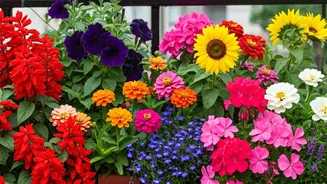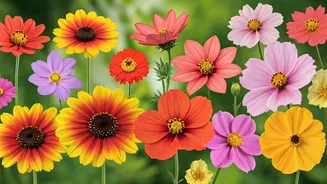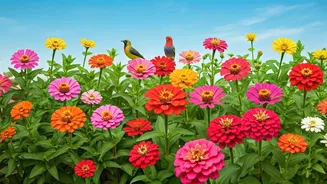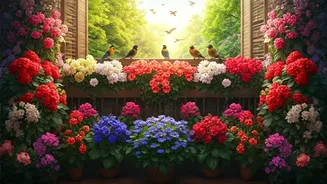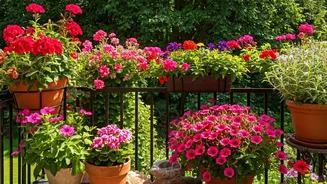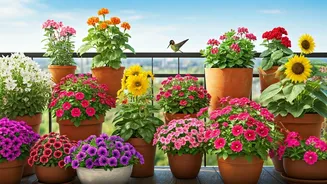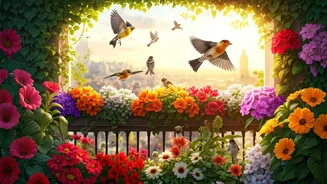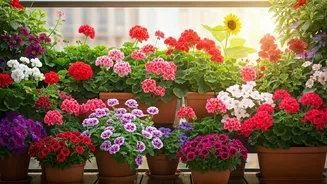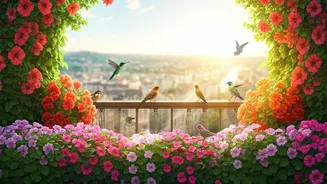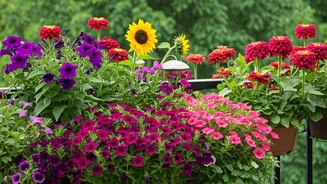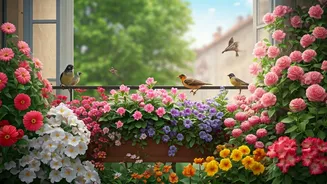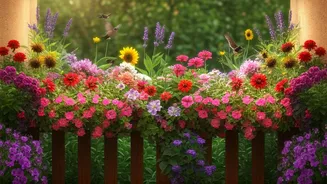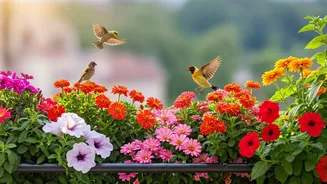Welcome Chirping Visitors
Creating a bird-friendly balcony garden requires thoughtful planning and the right plant selection. Birds are naturally drawn to specific flowers that
provide nectar, seeds, and shelter. Choosing a variety of blooms that flower at different times of the year can ensure a consistent food supply. This section delves into ten excellent flower choices that can turn your balcony into a buzzing avian paradise, offering a detailed look at each plant's characteristics and care needs to get you started.
Marigold’s Golden Allure
Marigolds, with their bright hues, are a fantastic addition to any balcony garden, renowned for attracting various bird species. These easy-to-grow annuals come in a range of yellows, oranges, and reds, providing a continuous burst of colour. They thrive in direct sunlight, requiring at least six hours of sunshine daily. Marigolds are relatively low-maintenance, needing regular watering and well-drained soil. They not only attract birds with their nectar but also offer a safe haven, particularly for smaller species. They tend to bloom from spring through fall, ensuring a long season of enjoyment.
Petunias: Colourful Variety
Petunias offer a wide array of colours and patterns, making them a versatile choice for balcony gardens. These cascading flowers look spectacular in hanging baskets or containers, adding vibrant appeal to your space. Petunias flourish in sunny locations, requiring consistent watering and well-draining soil. Their trumpet-shaped flowers produce ample nectar, attracting hummingbirds and other nectar-loving birds. Deadheading spent blooms encourages continuous flowering throughout the growing season. Different varieties allow you to create your own unique visual display and invite a multitude of bird species to your balcony.
Nasturtiums: Edible Delight
Nasturtiums are unique because they are not only beautiful but also edible, with a peppery flavour in both their leaves and flowers. These plants are easy to grow and thrive in a variety of conditions, needing only moderate sunlight and well-drained soil. They are particularly attractive to hummingbirds and also provide a food source for caterpillars, thus supporting the local ecosystem. Nasturtiums self-seed easily, ensuring that they return year after year. The leaves and flowers add visual interest to the garden while offering a tasty treat that both you and the birds will enjoy.
Zinnias: Butterfly Magnet
Zinnias are excellent for attracting butterflies and, by extension, birds. These bright and cheerful flowers come in many colours and sizes, providing a burst of colour to any balcony. They thrive in full sun and well-draining soil. Zinnias are relatively low-maintenance, requiring regular watering and deadheading to encourage continued blooming. They attract a variety of birds, especially seed-eating species, which are drawn to the seeds produced after the flowers fade. Planting zinnias helps create a vibrant and buzzing environment on your balcony, and these flowers are very attractive to butterflies that many birds feed on.
Sunflower’s Sunny Charm
Sunflowers, though large, can be grown in containers on a balcony, and they offer a significant attraction for birds. The height of the sunflower provides a visual element, and the flowers themselves are a source of seeds for many bird species. They need plenty of sunlight and well-drained soil. Sunflowers attract birds from the moment the seeds are planted, and they provide both visual interest and a valuable food source for various seed-eating species. As they mature, the large seed heads provide a feast, making them a favourite of birds from late summer through fall.
Lantana: Butterfly Beacon
Lantana is known for its ability to attract butterflies, which in turn draws insect-eating birds. These colorful flowers come in various shades, including pink, yellow, orange, and red. They are relatively easy to care for, thriving in full sun and well-draining soil. Lantana blooms throughout the warmer months, providing a continuous food source for both butterflies and the birds that feed on them. Regular watering is key, and pruning can encourage more prolific flowering. These plants transform your balcony into a bustling hub of activity, creating a lively atmosphere that wildlife can enjoy.
Salvia’s Hummingbird Appeal
Salvia varieties, especially those with bright red or purple flowers, are magnets for hummingbirds. These plants produce long, tubular blooms rich in nectar, which are particularly attractive to these birds. Salvia thrives in full sun and well-drained soil, making them a great option for sunny balconies. Regular watering is essential, and deadheading the spent flowers can extend the blooming period. Consider different types to extend the blooming season and attract various types of birds, especially hummingbirds, and provide a lovely, vibrant display.
Lavender: Fragrant Beauty
Lavender is not only fragrant and beautiful but also attracts pollinators, indirectly drawing in birds that feed on the insects drawn to the flowers. These plants prefer full sun and well-draining soil, thriving even in relatively dry conditions. Lavender's aromatic flowers and leaves can also provide shelter. Plant lavender in a well-lit location, and ensure good drainage to keep them healthy. While birds may not directly feed on lavender, the insects they attract create a good balance for their presence. Plus, the fragrance adds a soothing element to your balcony.
Coneflowers: Seed Feast
Coneflowers are particularly attractive to seed-eating birds. These daisy-like flowers come in various colours and are known for their resilience and ease of care. They thrive in full sun and well-drained soil, and they are relatively drought-tolerant once established. Coneflowers produce seeds that birds love, especially during the colder months. Leaving the flower heads in place over winter provides a valuable food source for these feathered friends. Planting coneflowers offers long-term benefits for a balcony garden and increases the chance of birds visiting year-round.
